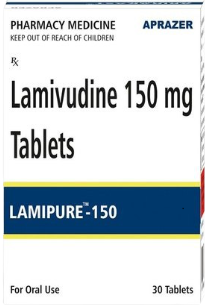HIV and AIDS – Myth Vs. Medicine
Lamipure 150
The lifelong, sometimes lethal disease, precisely known as acquired immunodeficiency syndrome (AIDS), is mostly brought on by the human immunodeficiency virus (HIV). HIV compromises your body’s capacity to fight disease and infection by weakening your immune system. Since it transfers its information backward into human DNA, HIV is known as a retrovirus.
The immune system’s CD4 cells, also known as helper T cells, are infected by HIV. This will cause white blood cell numbers to decline drastically due to the destruction of CD4 cells. Hence, even infections that ordinarily wouldn’t cause you to become ill can no longer be driven off by your immune system.
HIV originally makes you feel ill with symptoms resembling the flu. For example, Chills, Fever, painful throat, muscle pain, and Sweats during the night. After that, it can remain undetected in your body for a period of time without showing any signs. HIV/AIDS cannot be cured, although drugs can manage the infection and stop the disease’s progression.
International organizations are attempting to promote the accessibility of prevention strategies and care in resource-poor nations. Antiviral treatments for the HIV virus have decreased deaths due to this disease on a global scale. But during the past couple of years, a lot of false information about this fatal illness has also circulated, causing unnecessarily widespread alarm.
Myths surrounding AIDS
The idea that someone with HIV won’t live is among the most pervasive myths surrounding the disease. The fatality rate from AIDS was exceptionally high in the initial periods when the illness was an epidemic. But because of modern medications, people with HIV or even AIDS can lead much longer, healthier, and more productive lives. It’s possible that someone won’t ever contract AIDS if you immediately begin drug treatment and follow the recommended dosage.
The requirement to take numerous drugs every day is another widespread misconception. People with HIV had to take a large number of medications in the past. However, thanks to advances in medical research, most HIV patients now take one to four medicines each day when they first begin treatment. An individual might be able to seek treatment that contains two or three different medications in one capsule.
Treatment
Antigen, along with antibody tests, simple antibody tests, and tests for nucleic acid, are the 3 kinds of HIV tests available. Antigen analyses check for p24 markers on the HIV surface. Tests for HIV antigen/antibody look for both. These examinations search for HIV antibodies present in human blood or saliva. NAT checks detect HIV in the bloodstream and are comparable to antibody tests. HIV is treated with a daily oral regimen of one pill containing various medications or a combination of medications. This drug regimen is referred to as antiretroviral therapy (ART).
The best way to prevent HIV from spreading and killing cells is with these medications. Some of the most popular types of ART drugs are protease inhibitors, non-nucleoside reverse transcription inhibitors, and nucleoside reverse transcriptase inhibitors. For such a treatment, a tablet called Lamipure 150 is administered.
Mcneil and Argus Pharmaceuticals Limited produce it. One Lamipure film-coated tablet comprises microcrystalline cellulose, sodium starch glycolate, and magnesium stearate in addition to 300 or 150 mg of Lamipure 150(lamivudine). Lamipure 150 tablet’s formulation is based on a group of drugs known as nucleoside reverse transcriptase inhibitors (NRTIs).Lamipure 150(Lamivudine) uses include reducing the amount of HIV and hepatitis B in the blood.
The packaging bottle enables the storage of 30 tablets, making it an inexpensive and convenient option. Lamipure 150 medication should be consumed as advised by the medical professional.




 :
:  +91 – 9999064250 | 9811604444 | 9811604424
+91 – 9999064250 | 9811604444 | 9811604424

